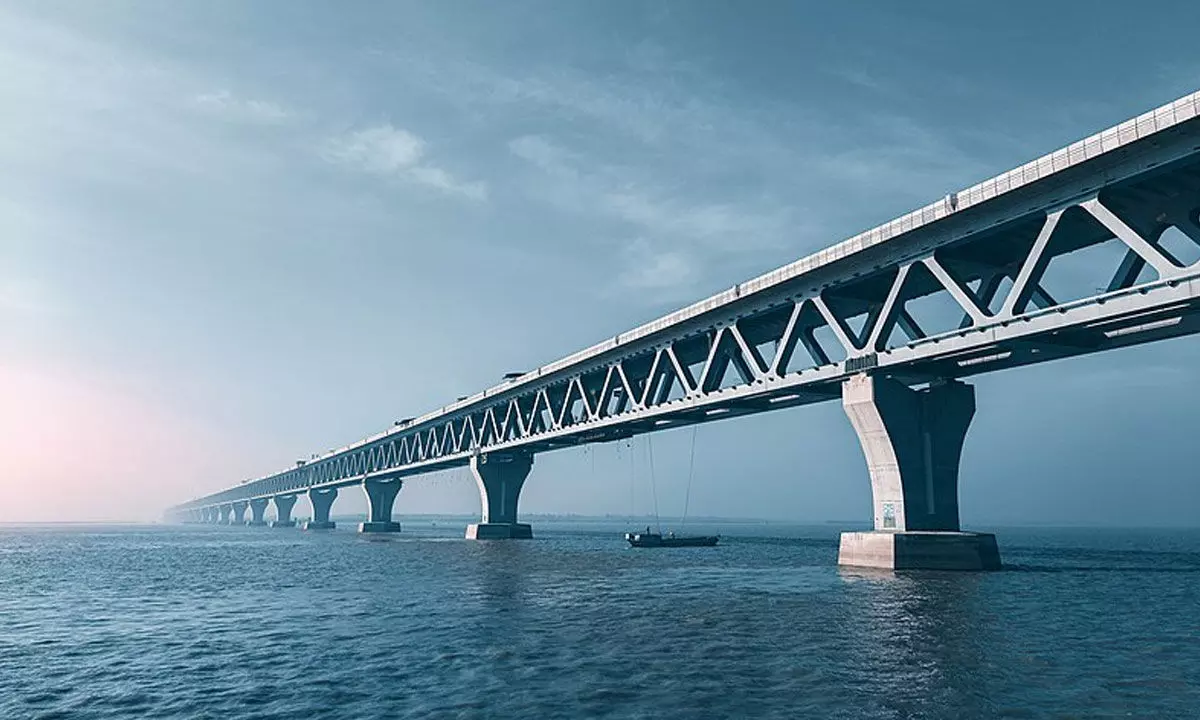Bridging connectivity divide key to enhance Indo-Bangla ties
The newly inaugurated Padma bridge in Bangladesh has opened new windows for India and Bangladesh to enhance their socio-economic and cultural ties.
image for illustrative purpose

The newly inaugurated Padma bridge in Bangladesh has opened new windows for India and Bangladesh to enhance their socio-economic and cultural ties. Three more bridges are expected to be opened in Bangladesh soon. Efforts are also there to bolster multi-modal connectivity through which complementarities of railways and waterways will synergize the desired transportation. Mind you that, Padma Setu is a dual-purpose bridge (having both rail and road links). The old rail link between Sealdah and Khulna can be revived and extended to the bridge. This could reduce the cost of trade exchange by more than 75 per cent. It will also reduce the congestion at Petrapole-Benapole area.
Stakeholders ought to materialize the potential for Indo-Bangla regional cooperation along with the imperative of transport connectivity which has significant implications for employment, women empowerment, and energy cooperation.
Some initiatives are already in motion for instance, BBIN-MVA, PIWTT, PIWTT (Protocol on Inland Waterways Transit & Trade. Transit facilities may reduce carrying time by half or more. Resulting benefits will ultimately reach consumers and it will also promote deepening value chains.
Operationalizing BBIN-MVA is pivotal (e.g. 'Maitree Setu' will connect Tripura with Chittagong port, which is only 75 km away). Bangladesh has received $510 million loan from India for three major railway projects (however, implementation has been slow). Bangladesh is planning to revitalize all pre-1965 rail connections with India. Waterways connectivity initiatives are already in motion (in July 2019, Indian cargo ship arrived at Narayanganj for the first time). If adequately facilitated, waterways connectivity can reduce travel costs by 30 per cent. Enhanced waterways connectivity can bolster MSMEs (mainly led by women) along the riverbanks. Development of inland waterways requires new financial and technological investments (focused on infrastructure). In Bangladesh, $753 million from ACCESS will upgrade 43-km two-lane Sylhet-Charkai-Sheola road to 4-lane to connect the Sheola land port. This will reduce travel time by 30 per cent. The project will support digital systems, infrastructure, and more streamlined processes at Benapole, Bhomra,and Burimari land ports. It will also support the modernization of the Chattogram customs house. Another $275 million ACCESS Project in Nepal will upgrade the 69 km two-lane Butwal-Gorusinghe-Chanauta road, along the East-West Highway.
The importance of transport connectivity can hardly be over-emphasised. Besides, North East (NE) India has a strong advantage of supplying agro produces for the vibrant food processing industry in Bangladesh.
NE India can also provide a market for the processed food exported by Bangladesh. Bangladesh-NE India connectivity needs to be further leveraged through extending railway networks and broad-gauging; making more airports operational and activating waterways.
The two countries must accelerate implementation of railways development projects initiated under LoC (delayed mainly due to bureaucratic complications). They must expedite twining of coastal and inland waterways transportation (e.g., Chittagong to Ashuganj). The two countries must make more border hats as entry points for people-to-people connectivity and transform border lines into free trade zones.
Overall, there are more opportunities than one for the two countries. Both countries have burgeoning consumer bases. Collaboration will enhance competitiveness. India's vibrant IT, healthcare, education sector can utilize the tech-savvy youthful human resource of Bangladesh and agricultural value chain development.
Potential for co-operation for faster and sustainable economic growth is therefore unlimited. Both countries are now politically poised to develop the infrastructures for desired level of co-operation.

